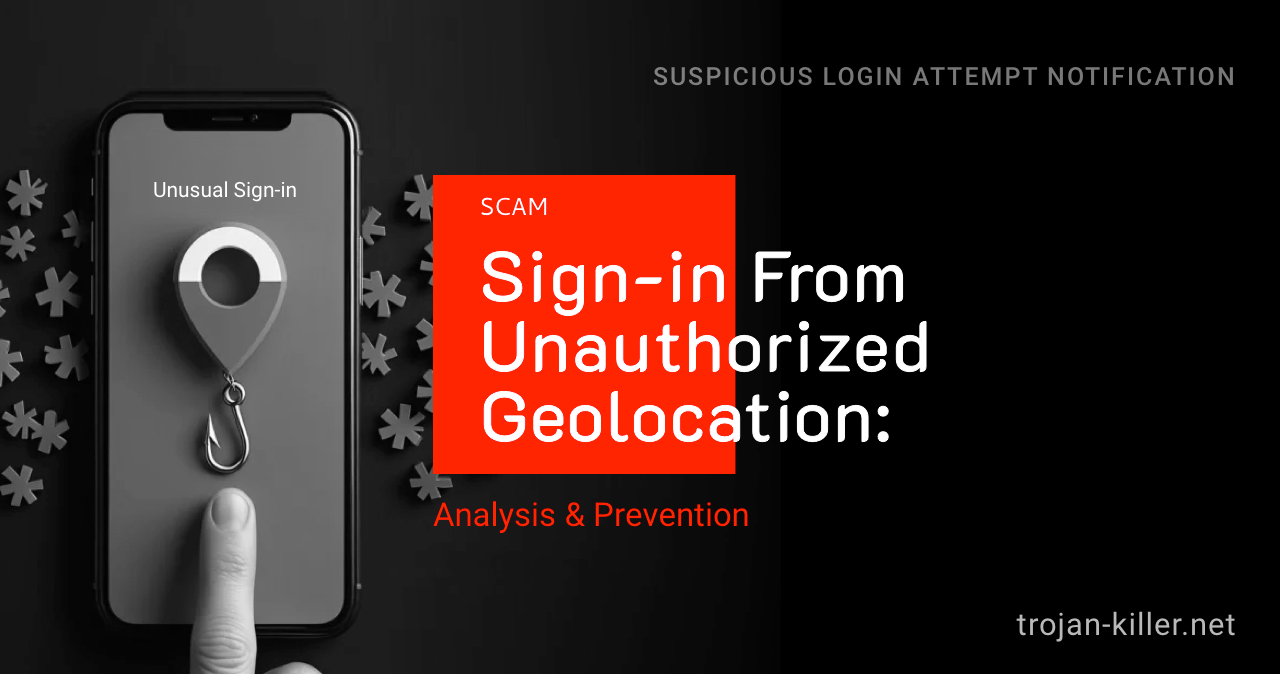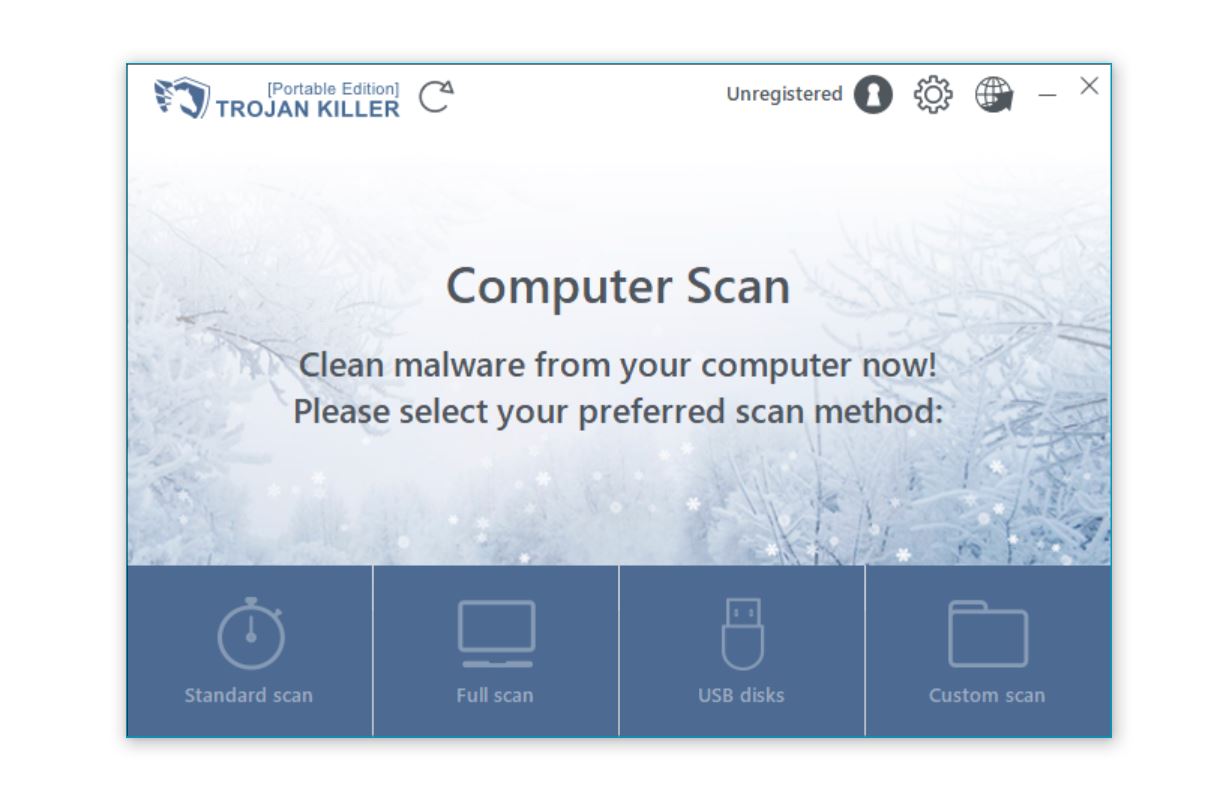Physical Address
Lesya Kurbasa 7B
03194 Kyiv, Kyivska obl, Ukraine
Physical Address
Lesya Kurbasa 7B
03194 Kyiv, Kyivska obl, Ukraine

The “Sign-in From Unauthorized Geolocation” email scam is a sophisticated phishing attack designed to steal your email account credentials by creating a false sense of urgency around account security. This comprehensive guide analyzes how these deceptive emails operate, how to identify them, and steps to protect yourself from potential identity theft and financial loss. By understanding these tactics, you can avoid falling victim to these increasingly convincing phishing attempts.
| Common Names |
|
| Type | Phishing, Scam, Social Engineering, Fraud |
| Platforms Affected | All email platforms and service providers |
| Fake Claim | Unusual sign-in detected from unauthorized location (often North Korea or Russia) |
| Risk Level | High – targets email credentials which can lead to multiple account compromises |
| Potential Damage | Identity theft, account takeover, unauthorized access to personal and financial information |
| Distribution Methods | Mass email campaigns, targeted phishing, compromised email accounts |
| Common Impersonations | Microsoft, Google, Yahoo, Apple, and other email service providers |
This scam represents a common credential phishing attack where cybercriminals impersonate legitimate email service providers to create panic about account security. According to the Federal Trade Commission, these security-themed phishing attempts are particularly effective because they exploit users’ fears about account compromise.
The fraudulent emails claim that an unusual login to your account has been detected from a suspicious location – typically a country associated with cyber threats like North Korea, Russia, or China. They include specific technical details such as IP addresses, browser types, and precise timestamps to appear legitimate. The message then urges immediate action to secure your account, directing you to click a link that leads to a convincing but fake login page designed to steal your credentials.
Identifying these scams requires attention to several suspicious elements:
Understanding the methodology behind these scams can help you identify and avoid them:
These phishing attempts are particularly effective because they leverage powerful psychological triggers to bypass our normal skepticism:
The “Sign-in From Unauthorized Geolocation” scam typically unfolds through several calculated stages:
According to Proofpoint research, these security alert impersonation tactics have become increasingly sophisticated, with attackers devoting significant resources to creating convincing replicas of legitimate service providers’ security notification emails and login pages.
For those interested in understanding the technical aspects of these scams:
A typical “Sign-in From Unauthorized Geolocation” phishing email contains several carefully crafted elements:
Below is the text from an actual phishing email:
Subject: Unusual mail sign-in from unauthorized geolocation
Mail account
Unusual mail sign-in from unauthorized geolocationWe detected something unusual about a recent sign-in to your mail account ********* on 23/3/2025 21:15:54 (GMT) from an unauthorized geolocation.
If this was you, then you can safely ignore this email.
Country/region: North Korea
Platform: One UI
Browser: Naenara
IP address: 175.45.177.11If this wasn’t you, your account has been compromised. Please follow these steps:
1. Reset your password.
2. Review your security info.
3. Learn how to make your account more secure.You can also opt out or change where you receive security notifications.
Security researchers can identify several technical red flags in the associated phishing websites:
The specific domain used in this campaign (tdmx.com.mx) was identified as a phishing site by multiple security vendors, including ESET, Fortinet, Sophos, and others, according to VirusTotal analysis.
Follow these best practices to avoid becoming a victim of these sophisticated phishing scams:
Email security software can provide an additional layer of protection against sophisticated phishing attempts:

Implement these security practices to minimize the risk of account compromise:
For comprehensive protection against phishing and account compromise, review the FTC’s recommendations on protecting your personal information.
If you suspect you’ve interacted with a “Sign-in From Unauthorized Geolocation” phishing email, take these steps immediately:
To verify the legitimacy of login alert emails, never click links in the email itself. Instead, open a new browser window and manually type in the official website address of your email provider (e.g., outlook.com, gmail.com). Once logged in, check your account’s security settings or recent activity logs to verify if any unusual logins actually occurred. Legitimate email providers usually have a section showing recent account access with locations and times. Additionally, examine the sender’s email address carefully; legitimate security alerts come from official domains, not public email services or slightly misspelled domains. Look for personalization in the message—legitimate alerts typically include your name and sometimes partial account information. When in doubt, contact your email provider’s official customer support through their website. Remember that legitimate services never ask you to send sensitive information via email or require immediate password entry through an email link.
Phishing emails frequently claim login attempts from North Korea or similar countries for several strategic reasons. First, North Korea is widely perceived as a hub for state-sponsored hacking activities, making the threat immediately seem credible and serious. The extreme geographical unlikelihood that an average user would actually be accessing their account from North Korea creates immediate concern and urgency—most recipients know they’ve never been to North Korea, so they instantly recognize this as suspicious activity. The mention of an adversarial nation also triggers heightened security concerns, as users associate such countries with cybercrime and espionage. Additionally, the specific technical details (like North Korean browsers such as “Naenara”) add a layer of seeming authenticity that many users wouldn’t have the knowledge to question. This psychological combination of fear, urgency, and specific unusual details overrides critical thinking and increases the likelihood that recipients will click links to “secure” their accounts without proper verification.
When you enter your credentials on a phishing site, scammers can gain access to a wealth of sensitive information beyond just your email account. First, they obtain your email address and password, which gives them full control of your email communications. With email access, they can view all your messages, potentially discovering financial statements, personal identification information, and confidential communications. Since most online accounts use email for password resets, attackers can gain access to your other accounts by requesting password resets. Many people reuse passwords across multiple sites, so scammers will try your email credentials on banking, shopping, and social media platforms. Your email inbox often contains sensitive attachments, contact information for friends and family (creating new phishing targets), and details about your personal life that can be used for identity theft or sophisticated social engineering attacks. Criminals may also use your compromised email to send phishing emails to your contacts, who are more likely to trust messages from someone they know.
Modern security software can detect many phishing emails, but detection is never 100% effective against sophisticated phishing attempts. Today’s security solutions employ multiple detection methods: they check known blacklists of phishing domains, analyze email content for suspicious patterns, and use machine learning to identify phishing indicators. Browser-based protection can warn when you visit known phishing sites, and email filters can quarantine suspicious messages. However, sophisticated phishers constantly evolve their tactics, creating ever more convincing emails that can sometimes evade detection. According to CISA (Cybersecurity and Infrastructure Security Agency), the most effective advanced phishing campaigns are tailored, using information gathered about targets from data breaches or social media to create highly personalized, convincing messages. For maximum protection, combine technical solutions with personal vigilance—always independently verify security alerts, enable multi-factor authentication, and approach unexpected security notifications with healthy skepticism, regardless of how legitimate they appear.
The “Sign-in From Unauthorized Geolocation” scam represents a sophisticated form of phishing that exploits our natural concern for account security. By creating convincing security alerts with specific technical details and alarming locations, these scams bypass our usual defenses and trick us into providing our login credentials to attackers.
The most effective defense against these attacks is a combination of technical protections and personal vigilance. By understanding how these scams operate, recognizing the warning signs, and implementing the protective measures outlined in this guide, you can significantly reduce your risk of becoming a victim.
Remember that legitimate email providers will never ask you to enter your credentials through an email link. Always access your account directly through your browser or official mobile app, enable two-factor authentication on all important accounts, and approach all security alerts with a healthy dose of skepticism.
If you receive a suspicious email claiming unusual account activity, the safest approach is to ignore the email’s links entirely, manually navigate to your account through your browser, and check your account’s actual activity logs directly. For additional protection against phishing attempts, consider using dedicated security solutions that can identify and block these sophisticated attacks.
Stay vigilant, verify independently, and protect your digital identity through strong authentication methods that go beyond just passwords. Your proactive approach to security is the most powerful defense against these increasingly convincing phishing attempts.